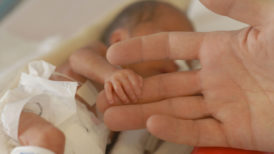Against heavy odds, the world’s tiniest and the fourth-smallest surviving infants have had normal childhood development, a new study shows, although the girls’ heights and weights still lag behind other kids the same age.
Little information is available to doctors and parents on how extremely low-birth-weight babies develop and grow as toddlers, school-age children, or into young adulthood. So a report like this offers a rare glimpse at the long-term health and growth of two of the world’s teeniest premature babies as they get older.
Rumaisa Rahman, a girl who holds the Guinness Book of World Records title of “World’s Smallest Surviving Baby,” is at her five-year follow-up doctor’s visit.
Born at just 26 weeks after her mother had severe preeclampsia, a serious condition involving high blood pressure and other abnormalities during pregnancy, Rumaisa was a twin. She weighed 9.2 ounces. She was roughly 9 inches long. Rumaisa spent 142 days in the hospital’s neonatal intensive care unit.
Madeline Mann is now a 22-year-old college senior. She was born at nearly 27 weeks into the pregnancy, also to a mother who had preeclampsia. She weighed roughly 9.9 ounces and was also about 9 inches long. Madeline was hospitalized for 122 days as a newborn before going home.
Her case is the first 20-year follow-up for one of the world’s smallest surviving infants reported in the medical literature.
Few babies born at birth weights of less than 14 ounces survive, so cases such as these are very rare. But the numbers of these “micro-preemies” who survive are on the rise.
The research appears in the Dec. 12 issue of Pediatrics.
Not Typical Outcomes
Both girls, who were born at the same Illinois hospital, showed normal language skills and hit normal milestones for walking and toilet training. Rumaisa’s movement skills — writing, grasping for toys, and getting dressed — are mildly delayed, while Madeline’s are described as normal.
Both girls remain small for their age for weight and height. Rumaisa is in first grade with an individualized education plan.
At 20, Madeline stood 4 feet, 7 inches and weighed about 65 pounds. Her growth has been consistently far below other girls her age.
“We tell parents of babies born this small not to expect their children to be super tall,” says researcher Jonathan Muraskas, MD.
Even so, he credits three main reasons for the girls’ relatively normal development. The first, says Muraskas, is that number of weeks of the pregnancy is much more important than birth weight for a child’s growth and brain development.
A second is that female preemies do better than males. “But we don’t know why,” says Muraskas, a professor of neonatal and perinatal medicine at Loyola University Medical Center in Maywood, Ill.
And a third reason is that both mothers were given steroids before birth. These medications help the baby’s lungs and brains mature faster and lower the risk of bleeding in the brain.
Muraskas points out that the two girls’ outcomes are not typical. Many micro-preemies either do not survive or grow up with disabilities from conditions such as cerebral palsy, mental retardation, and blindness.
While the researchers caution against considering their results as an expected outcome, it’s important for parents of these babies to recognize that there’s some hope.
“Good outcomes are possible even for the smallest babies,” says Edward Bell, MD, a neonatologist at the University of Iowa Children’s Hospital in Iowa City. He also says that for these tiny infants, the number of weeks spent inside the mother’s uterus affects their chances of survival more than their birth weight.
In 2000, Bell started a Tiniest Babies Registry when he realized he didn’t have good answers for parents’ questions about these babies who were born very premature.
Although information remains scarce, the registry has more than 100 babies who have survived weighing less than 14 ounces at birth.
“Most of them are doing pretty well,” Bell tells WebMD.
But this case report is not the norm, says Leslie Kerzner, MD, a neonatologist at Massachusetts General Hospital for Children in Boston. “[Rumaisa and Madeline] are two remarkable, isolated cases of survival of very low-birth-weight babies.”
It’s much more common for babies of this size to not survive or to have medical problems. “While these two girls may be the lucky ones, so many more suffer from hearing loss, vision, and movement problems, and [mental] delays,” Kerzner tells WebMD.
She says we still don’t know the long-term effects of the preemies’ long hospital stays. Nor do we know how much the babies’ discomfort and pain from their early-in-life medical care affects them later on.
Also, Kerzner says the report was not clear about how much special education or tutoring the girls need in school.

